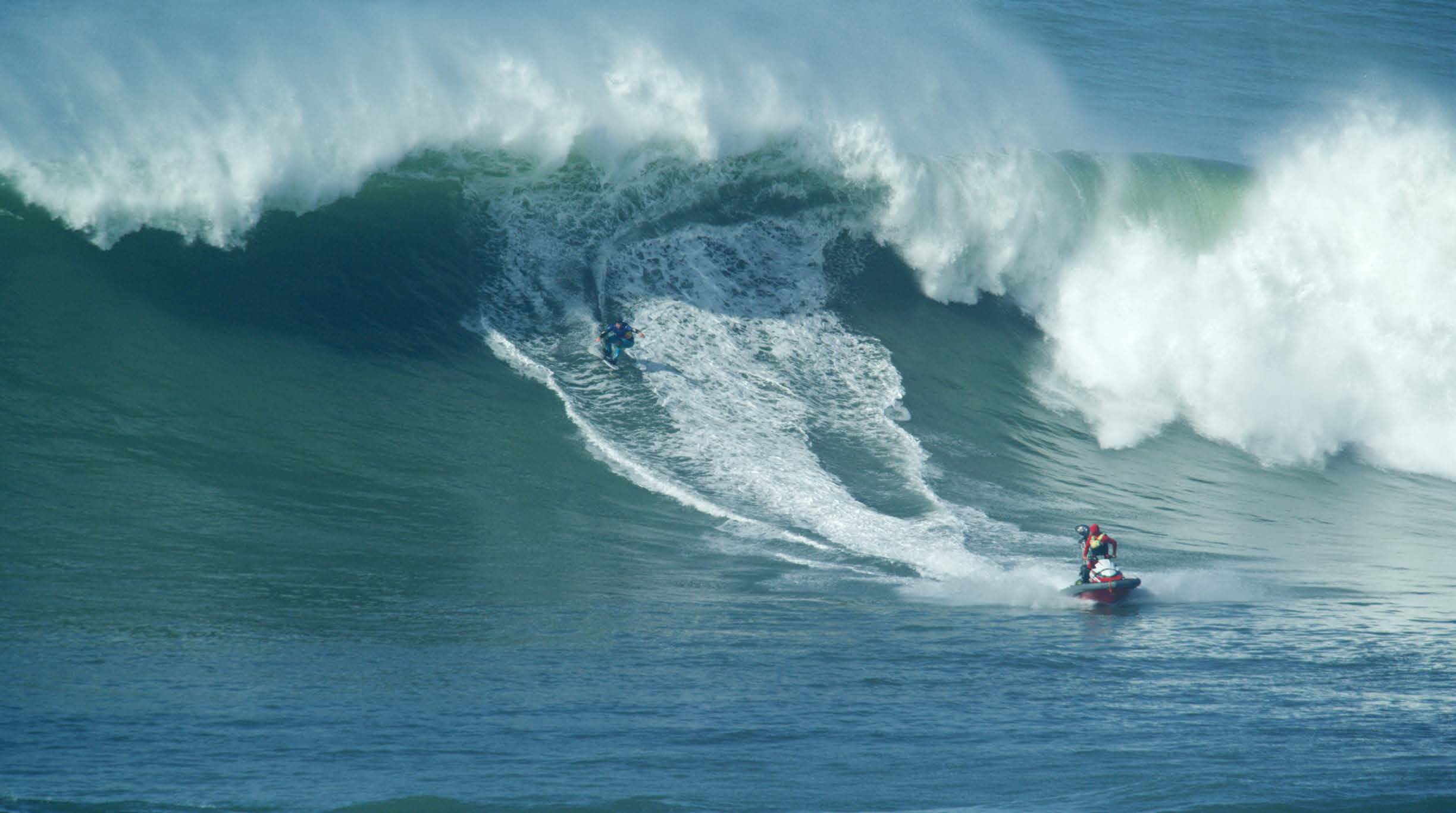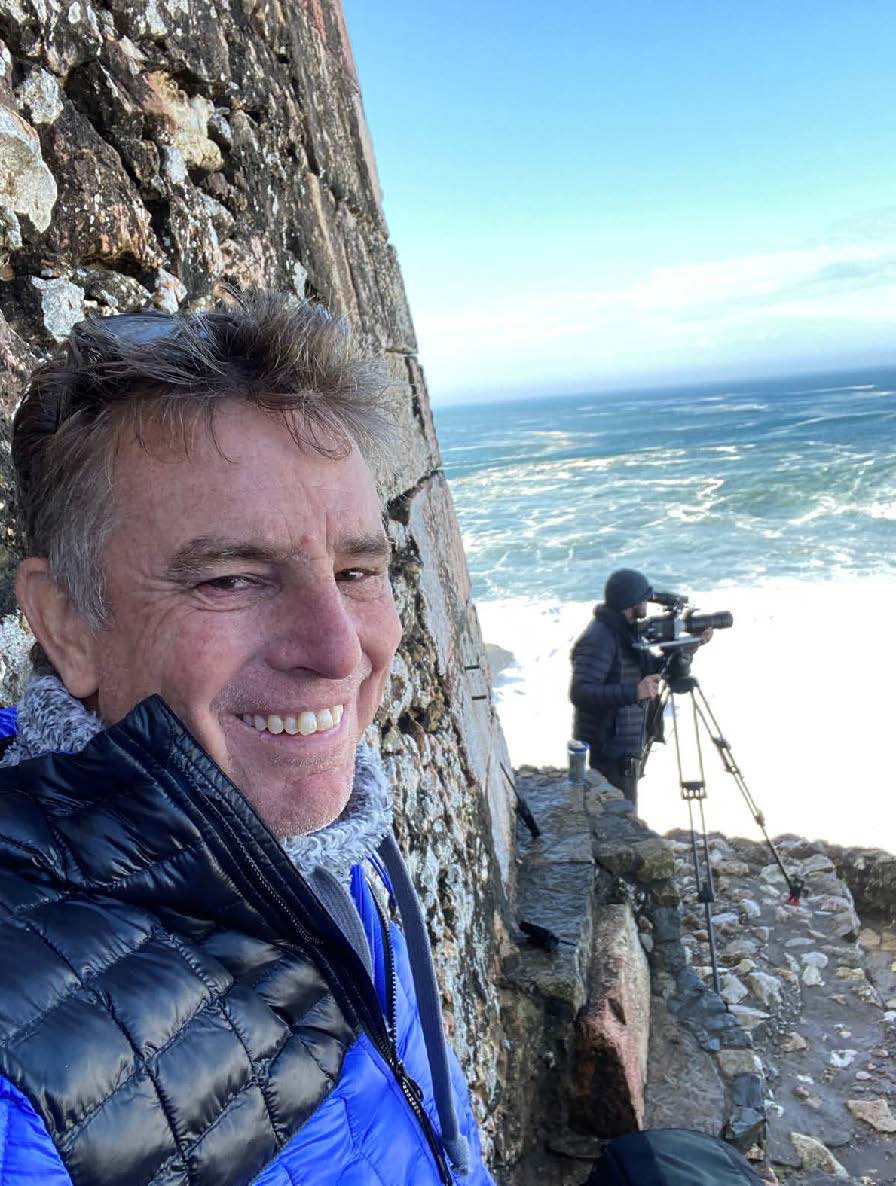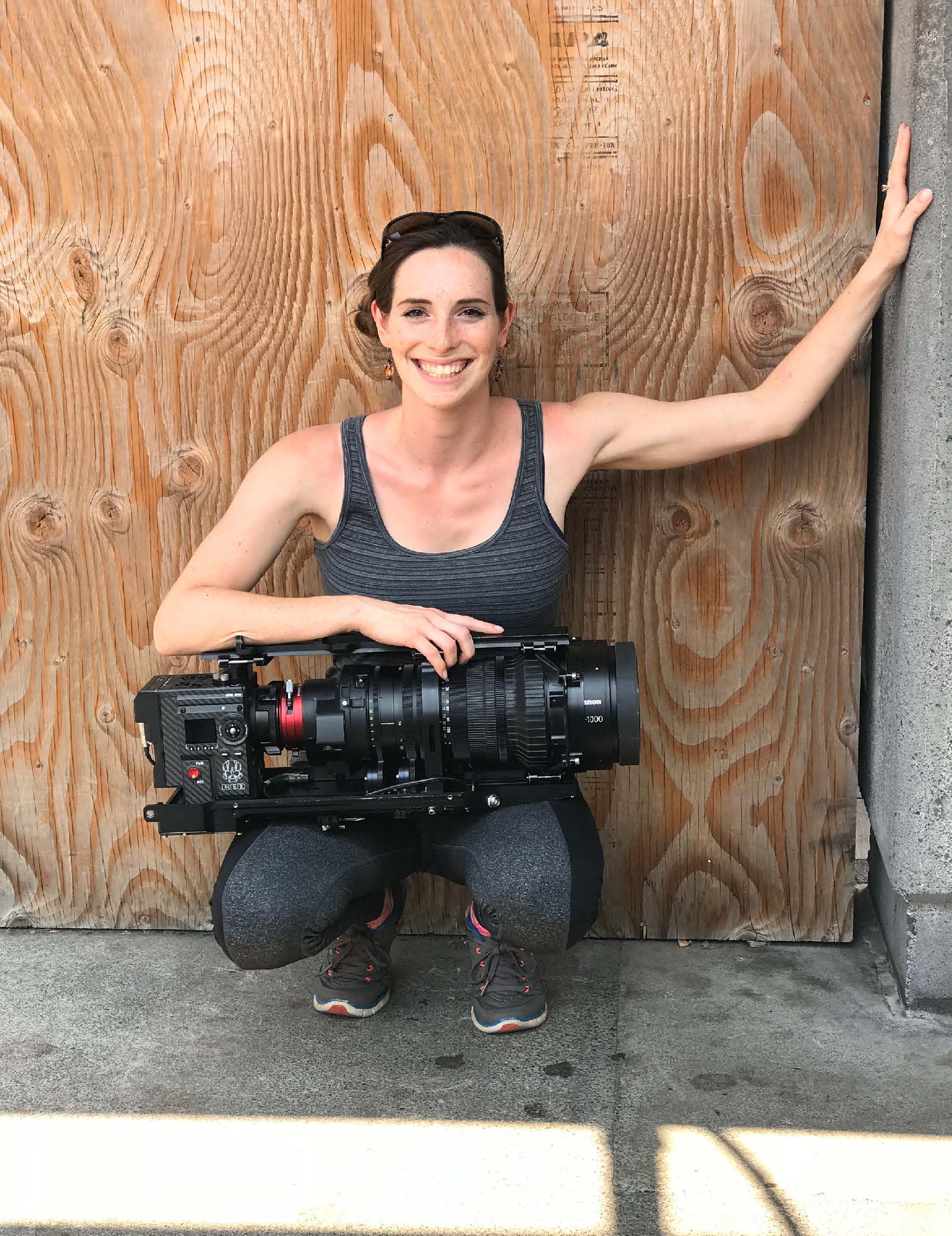 Michael Prickett, DP on the HBO documentary series 100 Foot Wave, won a 2022 Emmy for Outstanding Cinematography. The 6-part series centers on big wave surfer Garrett McNamara and giant waves at Nazaré, Portugal. Season 2 is coming soon. Season 1 is on HBO Max.
Michael Prickett, DP on the HBO documentary series 100 Foot Wave, won a 2022 Emmy for Outstanding Cinematography. The 6-part series centers on big wave surfer Garrett McNamara and giant waves at Nazaré, Portugal. Season 2 is coming soon. Season 1 is on HBO Max.
Jon: How did you get into this business?
Mike: I was a surfer when I was in high school on Oahu and I started taking pictures of my friends surfing. I was a still photographer originally and then started shooting 8mm, 16mm film. I loved it so much I ended up not surfing as much and kept shooting more and more. Then I fell in love with the Arriflex 16SR2. I think you wrote a book on that.
Good memory. Yes, I did. That was a great camera.
I still have it. I made a water housing and there’s never been one so well balanced. I made it out of fiberglass and plexi.
Cut to the present day. How did 100 Foot Wave begin and how did you manage logistics, camera packages and crew?
I made a movie called Chasing Mavericks with Gerard Butler. The 100 Foot Wave director and producers liked it and contacted me. Also I grew up with Garrett McNamara, the star of 100 Foot Wave so I actually had a bunch of archival footage of him.
What cameras did you have on the show?
We shot with Canon EOS C500 MkII cameras for the interviews, run-n-gun shots and for some long lens scenes. We sometimes had a dozen cameras running: RED MONSTRO 8K as our main cameras, V-RAPTOR, and a Phantom 4K Flex.
What did you have for underwater and splash housings?
Gates. I like Gates housings. We have these underwater SEABOBs that can go really fast underwater, I think 20 knots. It’s as if you’re a dolphin. So we put that Gates camera in front and you can zip around. It’s like a jet ski underwater. You hold it like a little dive scooter, but it’s on steroids. It looks like the James Bond of dive scooters. The camera’s right in front of the SEABOB. We also have different mounts. If you were on the surface, you could put the camera on top of it facing, sideways, and essentially you could do a dolly tracking move at water level.
We use scuba tanks sometimes, but mostly you just hold your breath, because that way you can go up and down fast. If you were on scuba tanks, going under waves would be really hard.
So the camera’s mounted right in front of the SEABOB. That way, wherever you’re going, it’s in the front.
What kind of cameras went onto the gimbals?
We had a RED MONSTRO 8K in there with a Canon CINE-SERVO 50-1000mm T5.0-8.9 50-1000mm zoom lens in a Shotover F1 Gimbal housing. We had at least three of those 50- 1000mm on the job.
We love that lens. We use Shotover gimbals on the helicopter a lot. And then we put the Shotover on sticks in the back of a boat and then we can use that gimbal with the 50-1000mm. The boat can be moving really fast, in and out of the wave, and you can zoom into someone’s eyes. It’s amazing: the gimbal is so steady even when the lens is zoomed in to 1000mm. It’s awesome.
Left: Canon CINE-SERVO 50-1000mm T5.0-8.9 50-1000mm. Right: Seabob with underwater camera housing in front.
Did you have camera assistants pulling focus?
Yes. Even on the remote control jet ski camera, we had a focus puller because I was so busy framing the camera. We used an ABonAir system. It’s a long range, low latency wireless video transmitter and receiver. I could operate and frame up the camera with that system. The focus puller was watching on the monitor and was using a Preston Hand Unit. This was essential, especially when I punched in tight at 1000mm to get the surfer’s face. We do the same thing in the helicopter. When I use the 50-1000mm in a helicopter we use a Preston as well.
Josh Quick added: The ABonAir model was the AB512 portable version. I rigged the Preston wireless control through the Shotover interface using a 900Mhz transmitter. Run/Start, focus, iris, zoom, pan, tilt, and roll were all controlled over that transmission. The AB512 units were used for microwave HD video transmission due
You can go all the way to 1000mm and it stays steady?
No problem. It actually has a built-in 1.4x extender so you can go to 1500mm and it’s still steady.
We also put a gimbal on the back of a jet ski. This is something that we kind of invented. It’s a little gimbal and we put a small compact zoom in it and we can control it from two miles away up on the cliff. We just have a driver of the jet ski and they can drop down the wave. If you watch episode five of 100 Foot Wave, you can see that gimbal and you can see us using it. You basically can tow the surfers in with the same jet ski that you’re filming with and then you can be in front of them, zooming and following them. We didn’t put the 50-1000mm in there though because it is obviously too big.
What kind of gimbal is on the jet ski?
That was a prototype. It was a B1 SHOTOVER gimbal, but now we use a GSS. GSS has a new gimbal that we put on the back of the ski. In the gimbal, we have a RED V-RAPTOR, so we can do higher frame rates, and a Canon CN-E 25-250mm T2.95 Zoom Lens. Of course, the V-RAPTOR is Full Frame, so we’re shooting in Super35 format. But the 25-250 covers full frame with its built-in 1.5x Teleconverter (Extender/Expander) engaged.
You’re mixing Full Frame and Super35 on this production?
Depending on the lenses and where the camera is mounted.
How do you keep spray off gimbal and camera on the jet ski?
We have a rain spinner that goes in front of the housing. You can hit it with a water hose and it remains clear.
Do you own all this equipment?
Yes. I think if I rented the equipment, the rental house people would probably say, “Oh my god, what are you doing with our stuff?” So we ended up buying everything that we use.
In Nazaré, where is the wave and the shore break in relation to that big giant cliff? It looks awfully close.
It’s right there. If you fall in the wave, you’re pretty much going to be into that cliff in 20 seconds or so. You really can’t fall. It’s pretty scary. Just a little to the right is the big shore break which is even more scary because that shore break is just crazy.
Is that big wave there all year round?
No, just a few times a year. It starts mid October and goes to the end of February or beginning of March. Kind of like the North Shore season out here in Hawaii.
Tell us about the crew. How did you round up all the usual surfing camera suspects?
We had a really good crew. Josh Quick is our main guy. He shoots, is like a master AC, and he helped me pick out the crew that we work with a lot. In our field of chasing big waves, it gets big in Hawaii and then we get on a plane and race to Mavericks in California to catch that same swell before it gets there. I picked the same group of people that we usually work with so everybody knew what to do. I can’t monitor each camera, because we had 15 cameras. So I had to trust their wisdom in getting good shots. Surfing’s such a different sport. I try to have crew who are used to shooting surfing.
We did monitor some stuff but it’s all line of sight. When the camera on a jet ski would go behind a 100 or an 80 foot wave, the water would block the signal. Even when the wave went by, the camera operators were on their own. They had to adjust the aperture or whatever on their own and make sure they had good framing. We had a lot of meetings in advance to explain what we were looking for. Then we had different LUTs for different times of day, in the fog and different kinds of conditions. Josh Quick set everybody up depending on what camera system they had.
Left: Jet Ski with gimbal remote operated by Mike Prickett. Right: Mike Prickett operating gimbal camera with joystick.
Which camera were you operating?
The RED MONSTRO. We would move around depending on the day. Sometimes in the morning it was really foggy and so we’d have to get closer so you weren’t shooting through as much fog, and then later in the day, we’d move around by the lighthouse on top of the cliff.
That was probably a good vantage point for the 50-1000mm?
You can cover almost everything with that fantastic Canon 50-1000mm lens. We also do a lot of work for the BBC and I think that’s a go-to camera as well for their nature shows.
You probably used Canon’s earlier go-to long zoom, the 150-600mm, a still lens modified for cine shooting.
I have that lens. I used one of those in Nazaré, rehoused by Otto Nemenz. I still have the Century Optics modified one too. I do have quite a few 150-600s. But my main lens is the 50-1000mm.
Did you have camera assistants pulling focus?
Yes. Even on the remote control jet ski camera, we had a focus puller because I was so busy framing the camera. We used an ABonAir system. It’s a long range, low latency wireless video transmitter and receiver. I could operate and frame up the camera with that system. The focus puller was watching on the monitor and was using a Preston Hand Unit. This was essential, especially when I punched in tight at 1000mm to get the surfer’s face. We do the same thing in the helicopter. When I use the 50-1000mm in a helicopter we use a Preston as well.
Josh Quick added: The ABonAir model was the AB512 portable version. I rigged the Preston wireless control through the Shotover interface using a 900Mhz transmitter. Run/Start, focus, iris, zoom, pan, tilt, and roll were all controlled over that transmission. The AB512 units were used for microwave HD video transmission due to their extremely low latency with sub-frame delays.
How do the jet skis towing and launching the surfers avoid getting knocked over by the actual wave?
It takes a lot of practice. Basically, the jet ski tows the surfer. Because in waves that big, it’s moving so fast that you can’t paddle in. They tow the surfer into the wave on a rope, and jet ski that tows them in is already in front of the wave. You just keep going in front of the wave, or it can go off the shoulder depending on what’s happening with that wave. And then there’s usually two other skis right behind that one that come in to do the pickup for that surfer.
Sometimes that same driver can pick them up, but they have to have a lot of safety, especially out there. There’s plastic and fishing nets and stuff in the water. If your jet ski sucks those up, it stalls. You can get caught inside and get in a lot of trouble real quick.
There are lot of safety skis. Just safety for the safety for the safety.
How did you wrangle all the data from 15 cameras?
Basically everyone had a hand in it. We had a DIT, who wasn’t like a separate DIT, because he was shooting and everyone wore lots of hats. All of us were downloading our cards at the end
of each day. We had 1 TB RED cards for the RED cameras and CFast cards for the Canon cameras. I’d say each camera shot about 2 TB per day. The interviews would take up quite a bit more because they’re constantly running.
Where did you position the cameras?
We had two in the water. Laurent Pujol, who also won an Emmy, was handheld in a housing on the back of a jet ski. I operated a remote control jet ski gimbal from up on the mountain. Two cameras were by the lighthouse, a wide and a tight. One at the harbor. Then, along the cliff, we had a 5 cameras every 50 or 75 yards. We had cameras on the beach and another gimbal camera on a little dune buggy that would go up and down so we could do tracking moves of the surfers, like a dolly. We had a FUJINON 20-120 T3.5 Super35 Cabrio in that gimbal.
How did you clean the salt water off the equipment each day?
That was a daily cleanup of everything. Windex on all the surfaces. Lens cleaner on the lenses. And Salt-Away on some of the bigger areas.
How do you clear the spray from the cameras while shooting?
If your camera is without a rain spinner, you’re constantly cleaning, often with a small squeegee or spitting on the lens. A raw potato works well. You cut it in half, put it in your pocket, rub it on the lens and the water just sheets off the lens really nicely.


















